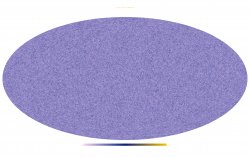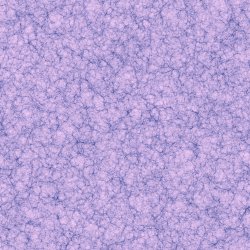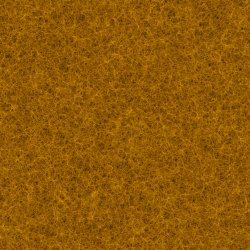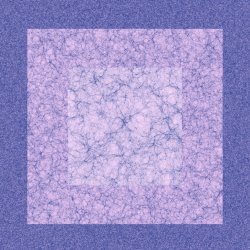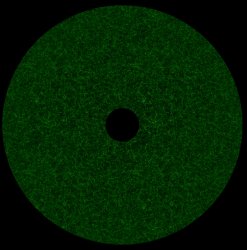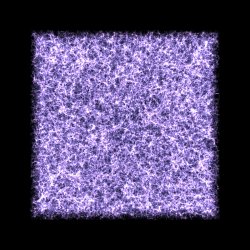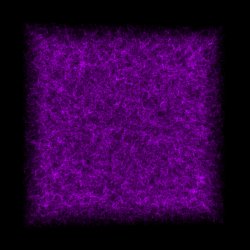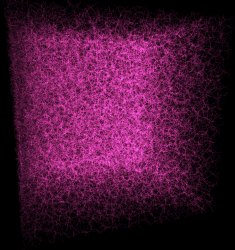
The site's hierarchy
Navigation
| M | T | W | T | F | S | S |
|---|---|---|---|---|---|---|
| 23 | 24 | 25 | 26 | 27 | 28 | 1 |
| 2 | 3 | 4 | 5 | 6 | 7 | 8 |
| 9 | 10 | 11 | 12 | 13 | 14 | 15 |
| 16 | 17 | 18 | 19 | 20 | 21 | 22 |
| 23 | 24 | 25 | 26 | 27 | 28 | 29 |
| 30 | 31 | 1 | 2 | 3 | 4 | 5 |
- CINES received a 150 TFlops machine
- GENCI has acquired for the French University Supercomputing Center a 12288 core SGI Altix. It is ranked 14th in the World and first in France.
- Site Web du CINES
- IDRIS received a 140 Tflops BlueGene/P machine.
- The CNRS supercomputing centre has acquired a new BlueGene machine with 40480 processors and 20 To of RAM memory.
- See the press release.
- Mare Nostrum simulation down to z=1.55
- We carried out our fourth run of MareNostrum down to z=1.55 while producing 150 Million "stars". More info is given here
- Horizon 4Pi 4096^3 down to z=0
- We have carried a full sky 2Gpc/h 4096^3 Dark Matter simulation down to z=0. More details can be found here
- Horizon 4Pi run 2048^3 completed
- We have completed a full sky cone run of DM with RAMSES on platine CEA with 2048^3 particles. See a slice here
- Mare Nostrum @ z=1.9
- We carried out our third run of MareNostrum down to z=1.9 while producing 120 Million "stars"
- Mare Nostrum simulation down to z=2.4
- We carried our second run on the Mare Nostrum supercomputing center down to z=2.4, thanks to 4-fold improvement in overall performance.
- 1024^3 500 h-1Mpc simulation completed
- RAMSES run of the HORIZON initial condition was carried down to z=0 using 1024^3 dark matter particles in a (500 Mpc/h)^3 box with up to 16 levels of refinement (corresponding to local effective resolution of 65536).
- Horizon 1024^3 100 Mpc/h simulation completed.
- A RAMSES run of the HORIZON initial condition was carried down to z=0 using 1024^3 dark matter particles in a (100 Mpc/h)^3 box with up to 16 levels of refinement (corresponding to local effective resolution of 65536).
- A 43 Tflops supercomputer at CEA
- CCRT, the supercomputing centre of CEA, has just received a new BULL supercomputer with 6800 processors and 13.6 Tb of RAM memory. This facility is dedicated to academic and industrial research.
- Lire le communiqué
- MareNostrum simulation published in HPCWire
- Lire l’article
- Fourth Horizon Workshop 2006b
- The 4th workshop takes place from December, the 11th to December, the 12th at Paris Observatory. Registration form available here.
- MareNostrum simulation has started at BSC
- After 1 week of operations, we have reached redshift 4. The simulation will proceed further more during the next quarters. We have started to post-process these initial data.
- Horizon Grid
- The Horizon grid is now in operation. It links the 6 quadri opteron of Meudon, Paris, Lyon, Saclay, IAP and Marseille and is open to all members of the collaboration. Voir ce lien
- http://grille.projet-horizon.fr
- Third Horizon Workshop 2006a
- Horizon Workshop 2006a 10, 11 and 12 april 2006 in Lyon. It will be dedicated to progress reports. Registration form
- Horizon is part of the DEISA "Extreme Computing Initiative"
- Horizon will launch one extreme application for galaxy formation using the DEISA infrastructure at Mare Nostrum http://www.bsc.es
- DEISA web site
- Second Horizon Workshop
- Horizon Workshop 2005 took place at Paris Observatory the 14th and 15th november. It was dedicated to internal discussions and management issues.
- October 2005: Horizon was awarded a 500 k€ grant by ANR, the French Science Foundation.
- Horizon response to «ANR Blanche» Call for Proposals has been succesfull in the «UNIVERS» program.
- ANR web site
- July 2005: HP France was selected to host the Horizon "meso-computer"
- HP company has succesfully answered the "call for proposals" issued by the Hrizon Project for a medium-size dedicated super-computer. The computer will be hosted at HPC1, the HP high performance computing center near Paris.
- February 2005: INSU and CEA agree to fund the Horizon "meso-machine".
- Horizon has submitted to INSU a proposal for funding a medium-size computer dedicated to the project. The proposal was accepted as a joint CEA and INSU operation.
- September 2004: Kick-off meeting in Paris
- During 3 days (13, 14 and 15 of september), 30 scientists have met at Observatoire de Paris to set up the basic organisation and objectives of the Horizon Project.
- KO Meeting
- April 2004: Horizon received official support from ASSNA.
- The french initiative «Action Spécifique pour les Simulations Numériques en Astrophysique» have given to the Horizon project its "label" for outstanding and structuring computational project.
- April 2004: The french Astroparticule program provides financial support for the Horizon "mini-grid"
- The Programme Astro-Particule, a joint IN2P3 and INSU initiative, has agreed to finance 6 quad AMD64 servers dedicated to the Horizon Project.
- January 2004: Review by PNC and PNG
- Both PNG and PNC scientific comitees are officially supporting the Horizon Project initiative.
- Theoretical Virtual Observatory workshop (IAP April 5-6, 2006)
A workshop dedicated to the Theoretical Virtual Observatory will take place at IAP on April 5-6th.
The goal is to bring together experts of the Virtual Observatory and theoreticians who would like to make results of their simulations (e.g. databases or catalogs) or numerical codes available to the worldwild astronomical community.
- Program and speakers
The Horizon Simulation
This "grand challenge" project features the largest N body simulation ever performed: we have simulated the 13.7 Gyr long evolution of 4096^3 dark matter particles in a 2 Gpc/h periodic box, running the RAMSES code for a couple of month on the 6144 processors of the new BULL supercomputer of the CEA supercomputing center (Centre de Calcul Recherche et Technologie).
The initial displacement field was computed on a 4096^3 base grid using the MPgrafic package. We use as initial conditions parameters the best fit values inferred from the 3 years observations of the WMAP satellite. The 70 billions particles were evolved using the Particle Mesh scheme of the RAMSES code on an adaptively refined grid (AMR) with more than 140 billions cells. We use more than 10 000 fine time steps at the deepest refinement level and 737 time step at the base level. Each of the 70 billions cells of the base grid was recursively refined up to 6 additional levels of refinement. We reached a formal resolution of 262144 cells in each direction (roughly 7 kpc/h comoving).
For the first time, we have performed a simulation of half the observable universe, with enough resolution to describe a Milky Way-like galaxy with more than 100 dark matter particles.
Our goal is to generate a Full Sky mock catalog with a realistic galaxy distribution up to redshift 1, as well as a deeper catalog with 500 square degrees up to redshift 7. In this way, we are definitely approaching the scale of the cosmological horizon, which is the hard limit of the observable universe (hence the name of the project).
The following people in the Horizon Project have spent nights and days monitoring and post-processing this huge simulation: D. Aubert, S. Colombi, J. Devriendt, P. Ocvirk, C. Pichon, S. Prunet, R. Teyssier.
We describe now in more details the results of this simulation.
Here is a movie describing the simulation results at the final epoch.
For higher resolution animations, please contact us. A spectacular zoomable unfolded image is also available here. It represents an oblic slice through the simulation at z=0 16x16 Gpc/h accross.
A mollweise representation (a projection of the sphere which attempts to display all the sphere on a plane) of the simulation at redshift 1 is shown here:
It assumes that the observer views all the night sky arround him but is only sensitive to the large scale structures of the universe at a distance of roughly 5 million light years. Another partial projection is shown there:
A thick slice of the simulation at z=0. is shown here:
And a thiner slice
. A VERY LARGE (97 Mega) image in 8192x8192 pixels is available here. Note that this image corresponds only to one level of refinement (another 5 levels are available). A composite image displaying all scales probed at the initial resolution of the simulation (without refinement).
The outer region corresponds to a view of the universe on scales of 16h^-1Gpc: it is generated by unfolding the simulation while cuting a slice obliquely through the cube in order to preserve the continuity of the field (thanks to the periodicity) See also below. The intermediate region corresponds to a slice of 2h^-1Gpc, while the inner region is at the original resolution of the initial conditions. RAMSES has refined 6 times over the course of the run from that resolution. A redshift slice through the Horizon-4pi universe is shown here
while a 3D view of its filaments is shown here:
A VERY LARGE (62 Mega) image of the unfolded universe (16x16 Mpc/h) in 8192x8192 pixels is available here. Note that this image is generated from a (![]() ) downgraded
version of the initial cube. Another view of this cube is shown here:
) downgraded
version of the initial cube. Another view of this cube is shown here:
while the skeleton of the structures within this cube is shown there:
Scientific Rationnal: Full sky weak lensing
A map of kappa (the weak lensing signal) is archived here (IT’S QUITE LARGE!). This image is a projection onto the sky the density of the dark matter.

